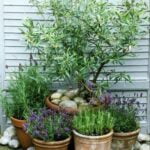Are you looking to maximize your small outdoor space but unsure where to start? Look no further. In this article, we will explore garden ideas for small gardens that will help you make the most out of your tiny oasis.
From vertical gardening and container gardening to creative seating options and landscaping tips, we’ve got you covered. Whether you have a balcony, patio, or just a small backyard, there are plenty of ways to transform your compact garden into a beautiful and functional retreat.
When it comes to small gardens, the key is to think creatively and strategically. With the right techniques and a little inspiration, you can turn your limited outdoor space into an inviting and stylish area that reflects your personality.
If you’re ready to unleash the full potential of your small garden, read on for practical tips and success stories that will inspire you to get started on your own mini oasis. Whether you are a gardening novice or seasoned pro, there’s something here for everyone who wants to make the most out of their small outdoor space.
Vertical Gardening
When it comes to small garden ideas, vertical gardening is a game-changer. Utilizing the vertical space in your small garden can help maximize the area you have available for planting. Trellises and wall planters are excellent tools for creating a lush and green oasis in even the tiniest of outdoor spaces.
Here are some practical and creative ways to incorporate vertical gardening into your small garden:
- Install trellises or arbors to grow climbing plants such as cucumbers, tomatoes, or beans.
- Use hanging planters or wall-mounted pots to add splashes of color and foliage to your vertical space.
- Consider incorporating a living wall or green facade using modular planters to create a stunning focal point.
By taking advantage of vertical gardening techniques, you can create a visually appealing garden without sacrificing precious square footage. Additionally, vertical gardens can provide insulation for buildings, promote biodiversity, and improve air quality by reducing pollutants – making them an environmentally friendly choice for small urban spaces.
Whether you’re looking to add privacy, maximize planting space, or simply enhance the aesthetic appeal of your small garden, trellises and wall planters offer endless possibilities for design and functionality. So get creative and start thinking vertically when it comes to your small garden.
Container Gardening
For sunny spots, consider planting herbs such as rosemary, thyme, and basil, as well as vibrant annual flowers like petunias, marigolds, and zinnias. These plants thrive in sunny conditions and will add a pop of color to your small garden. If your space receives less sunlight, opt for shade-loving plants such as ferns, hostas, and begonias. These plants not only tolerate lower light levels but also add lushness and texture to your container garden.
Another important consideration when choosing plants for container gardening is their ultimate size at maturity. Some plants may look deceivingly small when you purchase them from the nursery but can quickly outgrow their containers. To prevent overcrowding and ensure that all of your plants have ample space to thrive, research each plant’s mature size before making any purchases.
When it comes to container gardening in small spaces, creativity is key. Utilize hanging baskets and vertical planters to maximize space while adding visual interest to your garden. By carefully selecting the right plants for your containers and small spaces, you can create a lush oasis regardless of size limitations. There are numerous garden ideas for small gardens that can help you make the most of your limited outdoor space through creative planting solutions.
Creative Seating Options
When it comes to small garden ideas, creating a cozy and inviting outdoor space can be a challenge. However, with some creativity and strategic planning, you can turn your compact garden into a peaceful oasis for relaxation and entertainment.
DIY Benches and Seating Areas
One way to maximize seating in a small garden is by building or repurposing benches and seating areas. Consider using reclaimed wood or pallets to construct simple benches or seating platforms that can be tucked into corners or along walls. Adding cushions and outdoor pillows in coordinating colors and patterns will not only provide comfort but also add visual interest to your small garden.
Hanging Hammocks and Swing Chairs
Incorporating hanging hammocks or swing chairs is a unique way to add seating without taking up valuable floor space. These can be attached to sturdy tree branches, pergolas, or even installed on the exterior walls of your home. Not only do these options provide extra seating, but they also contribute to the cozy and relaxing atmosphere of your small garden.
Multipurpose Furniture
Another creative option for making the most of your small garden is investing in multipurpose furniture such as foldable tables, chairs with hidden storage compartments, or ottomans that double as planters. These versatile pieces allow you to optimize space while still providing functional seating options for enjoying your garden.
By incorporating these creative seating options into your small garden design, you can transform your limited outdoor space into a cozy oasis that is perfect for lounging, entertaining, and enjoying the beauty of nature.
Utilizing Every Inch
When dealing with a small garden, it’s essential to maximize the available space by arranging plants and landscaping thoughtfully. One of the key garden ideas for small gardens is to use vertical space. Consider adding trellises, wall planters, or hanging baskets to grow vines, flowers, and herbs upwards. This not only adds visual interest but also frees up precious ground space for other plants or seating areas.
Another important tip for arranging plants in a small garden is to choose plants that serve more than one purpose. For example, opt for dwarf fruit trees that provide both beauty and a harvest. Mix in some perennial herbs like rosemary or thyme that add fragrance and can be used in cooking. This way, you can get the most out of your limited planting area.
Additionally, when landscaping a small garden, consider creating different levels or using raised beds to add depth and dimension to the space. This not only adds visual interest but also allows for better organization and access when it comes to tending to your garden. By carefully arranging your plants and incorporating these tips into your gardening strategy, you can create a lush and inviting outdoor oasis in even the smallest of spaces.
| Garden Ideas | Small Gardens |
|---|---|
| Vertical gardening | Trellises and wall planters help maximize space |
| Multipurpose plants | Choose plants that serve more than one purpose |
| Landscaping tips | Create different levels or use raised beds for dimension |
Small Garden Maintenance
When it comes to maintaining a small garden, organization and tidiness are essential for maximizing the limited space available. With the right strategies and regular upkeep, you can ensure that your small garden remains a beautiful and functional oasis all year round.
Regular Pruning and Trimming
One key aspect of small garden maintenance is regular pruning and trimming of plants. This not only helps to keep your garden looking neat and tidy but also promotes healthy growth. Trim back overgrown branches, dead foliage, and unruly vines to maintain a well-manicured appearance.
Weed Control
In a small garden, weeds can quickly take over limited space if neglected. Regular weeding is crucial to keeping your garden organized and preventing invasive plants from overshadowing your carefully chosen flowers and shrubs. Consider using mulch or ground cover plants to suppress weed growth while adding visual interest to your garden.
Seasonal Clean-Up
Throughout the year, different seasons will bring about various maintenance tasks in your small garden. Make sure to clean up fallen leaves in the autumn, remove spent blooms in the summer, and protect delicate plants from frost in the winter. By staying on top of seasonal clean-up, you can preserve the overall tidiness of your small garden.
By implementing these maintenance practices, you can ensure that your small garden remains organized and tidy, providing you with a tranquil outdoor retreat regardless of its size. With thoughtful planning and attention to detail, even the smallest gardens can be kept looking their best throughout the year.
Adding Visual Interest
When it comes to small gardens, utilizing color, texture, and design is essential to make the space feel vibrant and visually appealing. One of the best garden ideas for small gardens is to use a variety of colors to create visual interest.
Consider planting flowers with different blooming seasons to ensure that there is always something in bloom throughout the year. Additionally, incorporating foliage with varying shades of green and different textures can add depth and dimension to your small garden.
Another way to elevate your small garden is by using design elements such as pathways, borders, and focal points. By carefully planning the layout of your garden and creating defined areas for different types of plants or features, you can make the most of the space you have. Introducing a focal point, such as a small water feature or a decorative sculpture, can also draw attention and create a sense of balance in your small garden.
In addition to color and design, incorporating different textures into your small garden can make it more visually appealing. This can be achieved through a combination of plant choices – consider mixing soft grasses with spiky succulents or delicate flowers with hardy shrubs. This contrast in textures adds interest and creates a dynamic look in your small garden.
| Key Visual Interest Elements | Details |
|---|---|
| Color Varieties | Planting flowers with different blooming seasons |
| Design Elements | Incorporating pathways, borders, and focal points |
| Texture Selection | Mixing different textures through plant choices |
Small Garden Success Stories
In conclusion, creating a beautiful and functional garden in a small space is definitely achievable with the right approach and creativity. By maximizing vertical space with trellises and wall planters, choosing the right plants for container gardening, and carefully arranging plants and landscaping, you can make the most of your small garden. Additionally, incorporating creative seating options and adding visual interest through color, texture, and design can transform your small garden into a cozy oasis.
Small garden success stories serve as inspiration for those looking to take on the challenge of transforming their own compact outdoor spaces. These real-life examples demonstrate that with thoughtful planning and dedication, even the tiniest of gardens have the potential to become stunning retreats. From balcony gardens to urban courtyards, there are countless ways to turn limited outdoor areas into thriving green sanctuaries.
Whether you have a tiny urban plot or a compact balcony, there are endless possibilities for turning your small garden into a verdant paradise. By implementing these garden ideas for small gardens and drawing inspiration from successful transformations, you can create a personalized outdoor haven that suits your style and preferences. With careful maintenance and a touch of ingenuity, you can enjoy the beauty of nature right outside your doorstep.
Frequently Asked Questions
How Can I Make My Small Garden Nice?
Making a small garden nice involves careful planning and maintenance. Choose the right plants for the space, create focal points, add decorative elements such as garden lights or colorful pots, and keep it tidy to enhance its beauty.
What Is Best for a Small Garden?
The best plants for a small garden are those that stay compact and don’t require a lot of maintenance. Consider planting dwarf shrubs, ornamental grasses, and perennials that offer continuous blooms. Also, using vertical space with climbers or hanging plants can maximize the area.
How Do You Arrange Plants in a Small Garden?
When arranging plants in a small garden, consider their mature size and growth habits to avoid overcrowding. Group plants with similar watering and sunlight needs together.
Create layers by placing taller plants at the back and shorter ones in front to add depth and visual interest to the garden. Lastly, incorporate pathways or borders to define different areas within the garden.

Welcome to my gardening blog! I am passionate about plants and enjoy sharing my knowledge and experiences with others. In this blog, I will write about everything related to gardening, from tips on how to get started to updates on my own garden projects.





